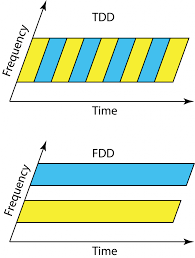Mobile Phone Technology

Frequency and Time Division Duplex.
image ©wireless future blogCommunications between a user and the base station needs to be both ways. In a full duplex system the communication between the user and the base station can occur at the same time, the user (and base station) can receive data at the same time as sending data. This is duplex communication and required for mobile communications.
For any mobile communication, the channel used must be shared between different users. There is just insufficient bandwidth to allocate a full channel to each user. This sharing is done by splitting the channel on frequency (FDD = Frequency Division Duplex) or time (Time Division Duplex).
In FDD the channel is split into sub-channels. A user has sole use of the sub-channel, with a narrower bandwidth and thus can send less data per second but the channel is shared between a number of users.
In TDD a user will have the whole of the channel for a timeslice, or a short period of time. A number of users will hence share the channel by time, again giving a fairer use of the available space.
Both of these systems can be used together, so the space available for a use is a block of part of the frequency, over part of the time. This allows for a more efficient multiplexing system of the available channel, which is fair to the users.
© mobilephonetechnology.co.uk all rights reserved 2017-2025
